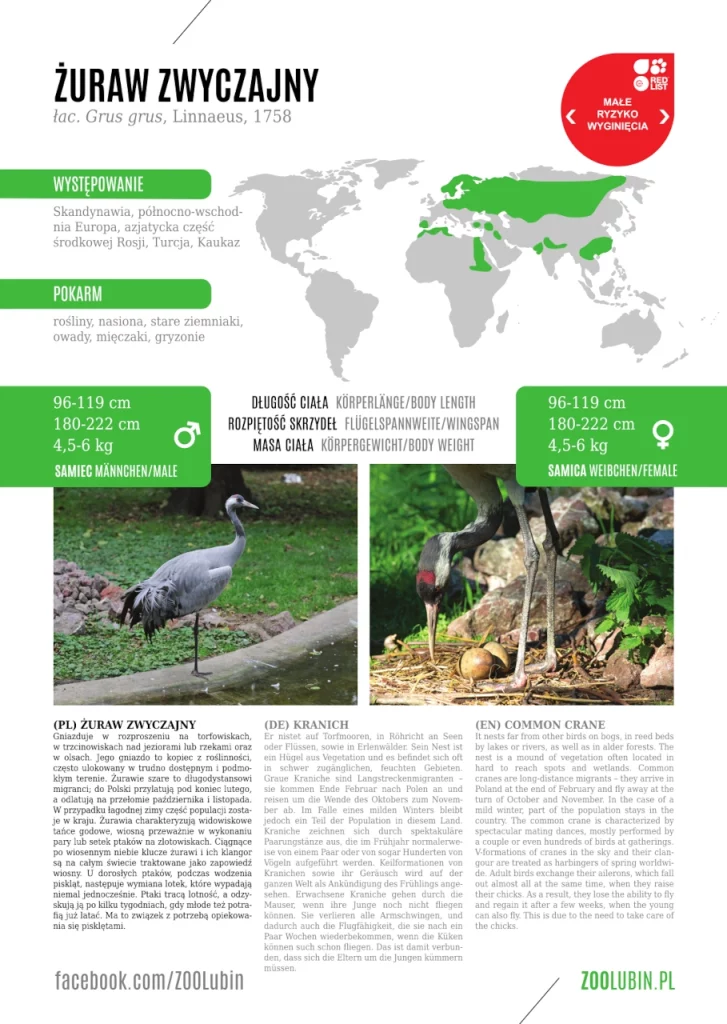
POBIERZ ETYKIETĘ GATUNKOWĄ – PLIK PDF (rozmiar 2848 KB)
Żuraw zwyczajny (PL)
łac. Grus grus, Linnaeus, 1758
Gniazduje w rozproszeniu; buduje kopiec z roślin, często ulokowany w trudno dostępnym i podmokłym terenie. Żurawie to długodystansowi migranci; do Polski przylatują pod koniec lutego, a odlatują na przełomie października i listopada. W przypadku łagodnej zimy część populacji zostaje w kraju. Ptak ten wyróżnia się widowiskowymi tańcami godowymi, wiosną w wykonaniu pary lub setek ptaków na zlotowiskach. Ciągnące po wiosennym niebie klucze żurawi traktowane są jako zapowiedź wiosny. Podczas wodzenia piskląt, u dorosłych następuje wymiana lotek, które wypadają niemal jednocześnie. Ptaki tracą wtedy lotność, a odzyskują ją po kilku tygodniach, gdy młode też potrafią już latać.
Występowanie: Skandynawia, pół.-wsch. Europa, azjatycka część środkowej Rosji, Turcja, Kaukaz
samiec / samica
Długość ciała: 96–119 cm
Rozpiętość skrzydeł: 180–220 cm
Masa ciała: 4,5–6 kg
Grauer Kranich (DE)
łac. Grus grus, Linnaeus, 1758
Dieser Vogel nistet verstreut; er baut einen Hügel aus Vegetation, der sich oft in schwer zugänglichen, feuchten Gebieten befindet. Graue Kraniche sind langstreckige Migranten – sie kommen Ende Februar nach Polen an und reisen um die Wende Oktobers zum November ab. Im Falle eines milden Winters bleibt ein Teil der Population in diesem Land. Kraniche zeichnen sich durch spektakuläre Paarungstänze aus, die im Frühjahr durch ein Paar oder Hunderte von Vögeln aufgeführt werden. Keilformationen des Kranichs auf dem Himmel sind als Ankündigung des Frühlings interpretiert. Als die Jungen schlüpfen, gehen erwachsene Kraniche durch die Mauser. Sie verlieren alle Armschwingen, und dadurch auch die Flugfähigkeit, die sie erst nach ein Paar Wochen wiederbekommen, wenn die Küken auch schon fliegen können.
Vorkommen: Skandinavien, Nordosteuropa, der asiatische Teil Zentralrusslands, die Türkei, der Kaukasus
Männchen / Weibchen
Körperlänge: 96–119 cm
Flügelspannweite: 180–220 cm
Körpermasse: 4,5–6 kg
Common crane (EN)
łac. Grus grus, Linnaeus, 1758
The common cranes nest at fair distances from each other; they build a mound from vegetation, often located in hard to reach spots and wetlands. These birds are long-distance migrants – they arrive in Poland at the end of February and fly away at the turn of October and November. In the case of a mild winter, a part of the population stays in the country. The common crane stands out due to its spectacular mating dances, performed by a couple or even hundreds of birds at gatherings. V-formations of cranes in the spring sky are interpreted as harbingers of spring. While caring for freshly hatched chicks, adult birds exchange their rectrices, which fall out almost all at the same time. As a result, they lose the ability to fly and regain it after a few weeks, when the young can also fly.
Distribution: Scandinavia, Northeastern Europe, the Asian part of Central Russia, Turkey, the Caucasus
male / female
body length: 96–119 cm
wingspan: 180–220 cm
body mass: 4,5–6 kg
